Baking Without Milk, Eggs, Soy, Wheat, Gluten and Nuts
by Colette Martin
Thank you to everyone who joined the Kids with Food Allergies webinar (click to view the video recording) on Wednesday, November 28th. It’s great to see so many of you baking. But there were so many questions and so little time! I don’t want to leave anyone feeling that their question was unanswered, so I will attempt to address the ones I can.
Keep in mind that these are general answers and what works for one family may not work for another. Always check with your allergist on which foods are safe for you. Likewise, information about vendor products can change, and what works for one family (e.g, whether or not to avoid foods with warning labels) will not work for everyone.
Because so many of you had similar questions, I have grouped them by topic.
REPLACING MILK
Q: What can I use as a substitute for evaporated milk?
A. I use powdered rice milk when I need evaporated or powdered milk. Be careful with powdered coconut milk as most of them contain dairy.
Q. I would love to have suggestions for baking substitutes for sweetened condensed milk and Cream of Mushroom soup.
A. For sweetened condensed milk I would use coconut creamer. I don’t use Cream of Mushroom soup. When I need a “creamed” vegetable sauce I use pureed cauliflower (here’s an example at learningtoeatallergyfree.com) – works like a charm!
Q: What is hemp milk made from?
A: Hemp milk is made from hemp seeds.
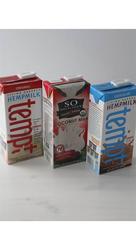
Q: If you have a seed allergy, is hemp milk safe?
A: Hemp allergy is rare, but be sure to check with your allergist.
Q: Is hemp milk gluten-free? Is hemp milk casein- and whey-free?
A. Hemp seeds are naturally gluten-free. None of the hemp milks I am familiar with add any gluten or dairy ingredients.
Q: Is hemp milk safe for children with peanut, egg, and tree nut allergies?
A. Check the labels, but the ones I’m familiar with are nut-free and egg-free.
Q: If you are allergic to soy, should you avoid rice milk because they are processed together?
A: It depends on your comfort level and the severity of your allergies, and whether you can find one processed in a separate facility, or on separate equipment. Check with your doctor.
Q: I can’t decide whether to use vanilla or plain non-dairy milk.
A. Whether to use vanilla or plain depends on what you plan to use it for. The vanilla versions are sometimes preferred for drinking. I use plain (or plain/original unsweetened) most of the time for baking. Many recipes for baked goods call for vanilla extract. If you choose to use vanilla non-dairy milk, leave out the added extract.
Q: What’s the difference between coconut milk in the can and coconut milk in the carton?
A. Traditional coconut milk in a can is very thick and fatty. The newer versions that come in a box are watered down and make a suitable (drinkable) replacement for dairy. If you want a cream, go for the canned version.
Q: I have a child who is old enough to start drinking milk, but she is allergic to dairy and soy. Is there a milk that would be good to give her at her age?
A. Check with your doctor as to whether hemp or coconut milk might be appropriate.
I am so excited that I am introducing so many of you to hemp milk – It’s one of my favorite foods, and my food-allergic son even uses hemp in his protein shakes.
REPLACING BUTTER
Q: Do you know of a dairy/soy-free butter substitute besides Earth Balance soy free spread? We love that, but it's really difficult to find where we live.
A. Coconut oil, or Spectrum Organics Shortening (palm oil).
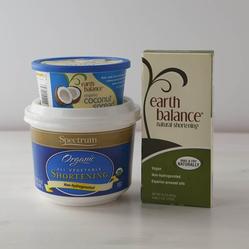
Q: Does Earth Balance have a soy free version of butter?
A: Earth Balance makes a soy-free buttery spread which comes in a tub. It can work as a shortening (or replacement for butter) but keep it very well-chilled as it will break down as you start to use it. Also, the new coconut spread from Earth Balance is dairy-free and soy-free.
Q: Can I use coconut oil to replace butter in cookie and muffin recipes?
A. Yes! Love this option!
Q: Do you use oils all at room temperature or do they need to be heated to melt them?
A: Coconut oil and Earth Balance natural shortening are both solid at room temperature. If I am using them in a recipe to replace oil, then I melt them (be careful not to burn them). If I need a shortening I used them chilled.
Also remember that most margarines contain dairy, and a lactose-free margarine does not mean it is dairy-free. Lactose is the sugar component of milk, and rarely the cause of allergic reactions. It’s the whey and casein proteins in milk that cause the problems.
REPLACING EGGS
Q: What is leavening?
A: It causes baked goods to have lift or rise. All baked goods need some amount of leavening, but muffins and cakes can usually rise enough with baking powder, while yeast breads need more lift.
Q: Is there a brand of flaxseed meal that doesn't have a tree nut warning?
A. King Arthur Flour makes one in a dedicated gluten-free and top-8 allergen-free facility.
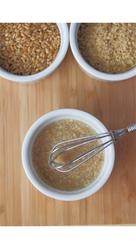
Q: Can vinegar be used to help with fluffiness of cakes, etc.?
A: Yes! This works best when you use a recipe formulated to take advantage of the vinegar, e.g., Wacky Cake.
Q: I've noticed that when using boxed egg replacer, I have to add more liquid. If doubling the baking powder, how much additional liquid would you have to add to make up for the liquid of the eggs?
A. You shouldn’t have to add more liquid because of doubling the baking powder, or because you used egg replacer. I suspect that you may be using too much flour. Adjust the flour for weight first.
Q: When baking with coconut flour and using an egg substitute, I've found it very difficult to replace eggs. Which egg substitution have you found works best?
A. It really depends on what you are making, and whether you are using the coconut flour alone (I wouldn’t) or in combination with other flours.
Q: When making cookies with egg replacement it comes out a gooey mess.
A. If you’re making egg-free cookies (or brownies) where sugar is the first ingredient you will get a gooey mess. Choose a recipe (or baking mix) that uses less sugar.
And a webinar attendee reminded us that pureed banana works similar to applesauce as a replacement for eggs. I agree!
REPLACING WHEAT
Q: Where can I find sorghum flour?
A: Bob’s Red Mill makes sorghum flour (facility processes tree nuts), as does King Arthur Flour (in a top-8 free facility), or look online.
Q: Would rice crumbs work instead of cornmeal?
A. Yes, depending on what you are making that could be a great option.
Q: Can you make your own quinoa flour?
A. Yes. If you have a high speed blender or food processor, you can make your own flour. Grind it very finely. I have done the same with buckwheat.
Q: Are there flour brands that are made in dedicated facilities?
A. King Arthur Flour and Namaste Foods both have dedicated top-8 free facilities. (Not all KAF products are made in that facility, check the labels.)
Q: Can flours be made from sunflower and sesame seeds rather than nuts like almonds?
A. I have heard of flours made from seeds, and I have used flaxseed and grapeseed flour myself. If you want to use them, use no more than ¼ cup in a 2-cup flour blend. These flours are too fine to hold their own.
Q: Do oats contain gluten?
A. Oats do not contain gluten. However, most oats are processed on the same equipment as wheat and can become contaminated. Look for oats labeled gluten-free.
Q: My gluten-free allergy bread bakes, rises and looks wonderful when it comes out of the oven. However, it falls shortly thereafter. What can I do to prevent this?
A. Oh, these kinds of questions are the kind I love, but it’s really hard to answer without knowing exactly what you used and how you prepared it. I am always suspicious first that you used too much flour. It could also be that you need more baking powder (don’t use baking soda for bread), or you let it proof too long.
Q: How do you know when flours and starches are bad?
A. Flour will smell rancid when it goes bad. Starches rarely go bad. Keep opened flours in the refrigerator.
Q: Does rice flour or rice syrup have brown rice?
A. Rice flours and rice syrups can be made from brown rice or other types of rice. Check the labels.
Q: Where can you buy wheat-free flours inexpensively or in bulk?
A. Sign up for website e-mails to get coupons. Try Amazon subscribe and save. This tip works for all types of ingredients!
Q: Can you share your favorite gluten-free flour blend?
A. My all-time favorite off-the-shelf flour blend is the King Arthur Flour Gluten-Free Whole Grain Blend, but it’s only available on their website or in their store. The King Arthur Flour GF Multi-Flour Blend in the blue and white box is an excellent rice-based blend. Both are made in their dedicated top-8 allergen-free facility. The latter is available in most grocery stores. That said, I just recently tried Pamela’s Artisan Flour Blend (see the review on my blog) and this could become a new favorite of mine but it’s not made in a dedicated facility, so check the labels!
There were a number of questions about finding the right flour blend. For those who need a rice-free flour blend, one option is Bob’s Red Mill (made from bean flours), but that one won’t be appropriate for those with legume allergies. Also, many of you pointed out that Bob’s Red Mill gluten-free products contain warning labels for tree nuts. I mention a lot of different brands because what works for one may not work for someone else. If both rice and tree nuts are a concern for you, you will need to mix your own, using some combination of other grains (sorghum, amaranth, quinoa, millet, buckwheat, etc.) along with at least one starch. Start by listing the grains you can use, and go from there. Combine at least two different flours with at least one starch in a two-cup flour blend. One example for a rice-free/bean-free blend would be: ¾ cup amaranth flour, ¾ cup sorghum flour, ½ cup tapioca starch. There are many ways to vary flours in blends. Baking with starches alone will result in a tasteless mess (trust me, I’ve tried it).
Some of you also asked questions about the best flour blend for a specific type of baking. The flour blend is less about what you are making, and more about the quality of the product (although I tend to use higher-starch flours for yeast breads and higher-protein flours for other baked goods). The truth is, not all gluten-free flour blends are created equal. Even with similar ingredients, some work better than others, and some are more consistent than others. Especially the rice-based blends can be crumbly. One excellent off-the-shelf rice-based GF flour blend that can be found in most grocery stores is King Arthur Flour (in the blue and white box).
ABOUT GUMS
Q. Is xanthan gum healthy? What is it exactly?
A. Xanthan gum is a created food (made from bacteria that is usually grown on corn syrup), and some folks choose to avoid it. Guar gum is a suitable substitute.
Q. Is there a choice instead of xanthan or guar gum?
A. If you choose to forego the gum completely, use a higher proportion of starch (at least ½ cup starch in a 2-cup blend) in your flour blend. Expect some crumbling if you do this.
Q: Do you add gums at the same time as the flour? If you add it after allowing yeast to rise, will it have the same effect or make it useless?
A. Always add gum to flour and dry ingredients before mixing the wet ingredients in. It’s virtually impossible to add once the bread has risen.
Q: I have read that you should add the gums to oil before adding it to your mix. Have you done this and does it improve your results?
A. I would not recommend this. Gums start to harden as soon as they find a liquid (and could even become a choking hazard if they harden too soon). They should always be mixed in well with the dry ingredients.
Q: Is gum a dry powder?
A: Yes. It’s a very fine dry powder.
Q: What does the gum do in the baking process?
A. It helps hold the other ingredients together. Without it, a bread will crumble when you try to slice it. If you’re interested in more of the “how and why,” my book, Learning to Bake Allergen-Free, explains this in detail.
ABOUT STARCHES and BAKING SODA/POWDER
Q: What are good cornstarch substitutes for baking?
A. Tapioca and/or arrowroot starch can be substituted 1-1 for cornstarch.
Q: Is baking soda safe for soy, peanut and tree nut allergy?
A: Yes, just read the label to make sure there isn't a contamination concern.
Q: Does baking powder ever contain an allergen to look out for?
A: Most baking powders corn starch. Featherweight Baking powder is one corn-free option (made with potato starch).
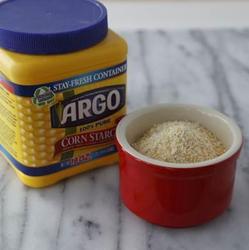
Q: What is arrowroot? Are people allergic to some of these less known ingredients?
A: Arrowroot is a starch that comes from a root vegetable. It is rare to have an allergy to arrowroot; but it is possible to be allergic to anything.
Q: What is tapioca?
A: Tapioca is also known as cassava or manioc. It is a root that is full of starch.
Q: Is tapioca starch the same as tapioca pudding?
A: The tapioca used to make pudding is the whole form of tapioca. The flour or starch is a ground version of that grain.
Q: Can arrowroot and tapioca be used in place of baking powder?
A. A starch doesn’t do the same thing as baking powder, so no – not a replacement.
OFF-THE-SHELF BAKING MIXES
Q: What is the best option to replace egg when making a boxed cake? I've tried to use egg replacer but my cakes always come out crumbly.
A. With a cake mix I would use applesauce or flaxseed gel to replace the egg. The texture helps hold it together.
Q: What chocolate muffin or cake mix do you like the best?
A. My favorite off-the-shelf chocolate cake mix is from Gluten-Free Pantry (Decadent Chocolate Cake). I like to use Namaste Foods No-Sugar Added mix to make chocolate muffins.
As with flours, off-the-shelf baking mixes are not created equal. Some perform much better than others, regardless of the substitutions. In my book, Learning to Bake Allergen-Free, I include an entire chapter of recipes from off-the-shelf mixes, showing what substitutes to use.
OTHER QUESTIONS
Q: Does soy nut butter contain the soy protein that causes allergic reactions?
A. Yes. Soy nut butters contain protein and those allergic to soy would be allergic to it.
Q: I need a non-dairy chocolate. Is pure cocoa dairy-free?
A. Both pure cocoa powder and cocoa butter (despite it’s name) are dairy-free. One great brand for chocolate chips is Enjoy Life. There are many sources for powdered cocoa.
Q: My son has EoE and I am concerned he is getting the nutrition he needs. Are there any resources to make sure he is getting enough calcium etc.?
A. This is a question for a doctor or nutritionist, but this is one of the reasons why my son (who also has EoE) drinks a lot of hemp milk – it is naturally high in calcium. We also buy the calcium fortified orange juice.
[Note: EoE means eosinophilic esophagitis, a type of food allergy that affects the gastrointestinal tract.]
Q: My 3 year old is asking for a sandwich. Is there an allergen-free bread on the market?
A, Most off-the-shelf breads that are gluten-free and dairy-free contain eggs. One brand that makes a couple of egg-free version is Foods for Life (both a millet and a rice bread). I also have a basic sandwich bread recipe in my book, Learning to Bake Allergen-Free.
Q: If I’m using agave nectar, should I adjust my oil/eggs substitutes?
A. No. You would be using the agave instead of sugar. Sugar liquefies when heated – think of it as a liquid.
Q: When breading, how do you get the flax seed/chia seed gel to stick to the meat?
A. This might be a surprising answer, but I don’t. When using a breaded coating I don’t use an egg replacer. I simply use moist meat or dip the meat in a non-dairy milk before coating.
Q: Is there an alternative to Sunbutter (processed in plant with soy).
A: There are other sunflower seed butters out there (check the labels for processing). You can also make your own. There is a recipe in the KFA Safe Eats recipe database, and I recently did a YouTube video on making your own sunflower seed butter.
Whew! That’s a lot of questions! I tried to touch on everything asked, but if you think we missed something, leave a comment.
I really appreciate all the great comments about the webinar and the positive comments about my book. The first part of the book contains a lot of information on ingredients and how they work together. The second part is full of recipes (with a focus on basics) and tons of how-to tips and tricks! The recipes are very flexible for those who need to swap out more ingredients as well as those who can use some of the ingredients I left out. For those of you who asked where to find it – Learning to Bake Allergen-Free is available on Amazon.com, at Barnes and Noble, and all major bookstores. It’s available in paperback and all electronic formats.
Have a fabulous gluten-free and allergen-free holiday. Don’t forget to leave some hemp milk and allergen-free cookies for Santa!
--Colette

Colette Martin is a writer, speaker, and thirty-year veteran of Corporate America. Colette is also a food allergy mom and an expert on how to bake allergen-free. When her son was diagnosed with eosinophilic esophagitis in 2001, triggered by allergies to wheat, milk, eggs, soy and peanuts, she had to reinvent how her family ate. Having first learned to bake in her grandmother’s kitchen with wheat, butter, milk, and eggs, Colette understands first-hand what it means to transform her kitchen to accommodate multiple food allergies. You can reach Colette on Facebook, Twitter, her blog, and on YouTube.

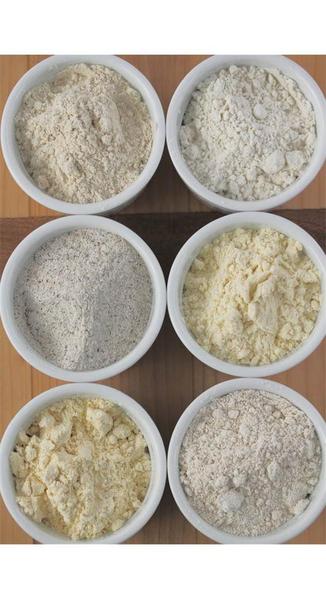






Comments (5)